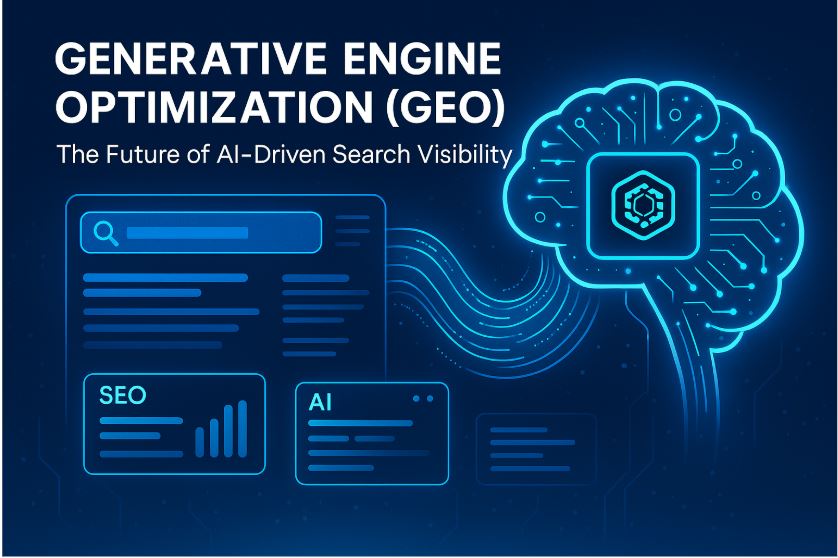
Generative Engine Optimization (GEO): The Future of Search Visibility
Introduction
In the ever-evolving digital landscape, Generative Engine Optimization (GEO) is emerging as a crucial strategy for content creators and marketers. Unlike traditional Search Engine Optimization (SEO), which focuses on ranking websites in search engines like Google, GEO aims to enhance content visibility in AI-driven generative models such as ChatGPT, Gemini, and Claude. This shift is transforming how content is discovered, making GEO an essential technique for businesses and content marketers.
Understanding Generative Engine Optimization (GEO)
GEO is the process of structuring, optimizing, and enhancing content so that AI-driven search engines recognize and present it effectively. As AI-powered assistants increasingly provide users with direct answers instead of traditional search result links, content creators must adapt their strategies to stay relevant.
Unlike SEO, which revolves around keywords, backlinks, and metadata, GEO emphasizes content clarity, semantic relevance, authority, and up-to-date information. The primary goal is to make information more digestible for AI models, ensuring it is referenced in responses generated by artificial intelligence.
Why GEO Matters in the Age of AI Search
With the rise of AI-powered search engines, GEO is no longer an option but a necessity. Users are now asking AI models for information instead of browsing multiple web pages. If content is not optimized for generative AI, it risks becoming invisible in this new search paradigm. Here are key reasons why GEO is crucial:
- Shifting Search Behavior – Users increasingly rely on AI-generated answers rather than scrolling through multiple search results.
- AI Summarization – Generative models summarize vast amounts of content, making it essential to structure content effectively to be included in these summaries.
- Authority & Credibility – AI models prioritize trustworthy, high-quality sources, making credibility a vital factor in GEO.
- Voice Search & Conversational AI – Optimizing for natural language processing ensures content is accessible via voice search and AI-driven assistants.
Key Principles of Generative Engine Optimization (GEO)
For content to be effectively recognized by AI-driven search engines, it must follow certain principles:
1. Content Authority & Trustworthiness
AI models prioritize authoritative sources. Websites and brands must establish themselves as reliable and credible to be referenced frequently in AI-generated responses. This can be achieved through:
- Publishing well-researched and factually accurate content.
- Citing reputable sources and experts.
- Gaining recognition through backlinks from authoritative websites.
2. Structured Data & Readability
Unlike human users, AI models process vast amounts of data quickly. Content that follows structured formats is more likely to be selected by AI. Strategies to improve structure include:
- Using headings (H1, H2, H3, etc.) effectively.
- Formatting content with bullet points and numbered lists.
- Providing concise and well-organized answers.
3. Comprehensive & In-Depth Content
AI prefers content that covers topics thoroughly. To increase the likelihood of content being referenced:
- Address all aspects of a topic.
- Include FAQs and related queries.
- Use examples, statistics, and case studies.
4. Semantic Relevance & Contextual Optimization
Traditional SEO relies on keyword density, but AI-driven models use semantic understanding. To optimize for GEO:
- Use synonyms and related terms naturally.
- Write in a conversational, human-like tone.
- Ensure content aligns with user intent.
5. Updated & Fresh Content
AI models prioritize the most recent and accurate information. Regular updates help maintain relevance:
- Refresh old content with new statistics.
- Add recent industry developments.
- Monitor AI trends to adjust content accordingly.
How to Implement GEO for Maximum Visibility
Adopting Generative Engine Optimization requires a combination of technical and content-focused strategies. Below are practical steps to implement GEO effectively:
1. Optimize for Featured Snippets & Direct Answers
Generative AI often pulls information from featured snippets. To increase the chances of being cited:
- Answer key questions directly at the beginning of articles.
- Use structured formats, such as tables, bulleted lists, and step-by-step guides.
- Include schema markup to help AI understand content better.
2. Improve Content Quality & Engagement
- Ensure content is clear, engaging, and easy to read.
- Use storytelling techniques and real-world examples.
- Encourage user interaction, such as comments and discussions.
3. Leverage AI for Content Optimization
- Use AI tools to analyze readability, relevance, and keyword optimization.
- Implement AI-generated summaries to test how models interpret your content.
4. Monitor Performance & AI Visibility
Since traditional SEO metrics don’t fully apply to GEO, alternative performance indicators include:
- Tracking AI-generated citations and references.
- Using AI tools to check how content appears in responses.
- Observing user engagement and retention trends.
Challenges & Considerations in GEO
While Generative Engine Optimization offers a promising future, it also presents some challenges:
- Measuring Success – Unlike SEO, there are limited direct analytics tools for tracking GEO performance.
- Adaptation to AI Algorithms – AI models constantly evolve, requiring continuous optimization strategies.
- Ethical Considerations – Over-optimizing for AI could lead to misinformation or biased content promotion.
The Future of GEO: What’s Next?
As AI models become more advanced, GEO will continue evolving. Future developments may include:
- AI-Specific Ranking Factors – New ranking metrics tailored to AI-generated content visibility.
- Better AI Content Attribution – Improved transparency in how AI models reference sources.
- Integration with Voice Assistants – Optimizing for voice-based AI interactions.
Conclusion
Generative Engine Optimization (GEO) is revolutionizing digital marketing and content strategy. With AI-driven search engines reshaping how users access information, optimizing content for semantic relevance, authority, and clarity is key to maintaining visibility. Businesses, brands, and content creators who adapt to GEO principles will secure a competitive advantage in the AI-powered search era.
By implementing structured formatting, up-to-date insights, and conversational clarity, your content can be effectively recognized by AI search engines and remain a valuable resource for users. Embracing GEO now will ensure long-term success in the evolving digital landscape.
Leave a Reply